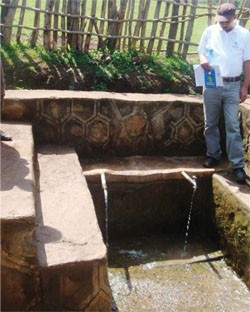15.4 Spring source protection
There may not be many opportunities to develop new spring sources but, if the opportunity does arise, there are certain procedures to follow to ensure the spring water is protected and safe to drink. You would be working with others if a new spring source was to be developed but the same principles will apply to existing spring sources because the protection needs to continue to work into the future.
Before using a spring a thorough sanitary survey needs to be carried out at the site to assess the quantity and quality of water, and the possible contamination. (Sanitary surveys are described in Study Session 16.) If the results of the sanitary survey are satisfactory, the eye of the spring (the point where the water emerges from the ground) should be located by digging out the area around the spring down to the impermeable layer.
Different types of spring protection can be constructed but in general they are as follows:
- A concrete waterproof protection box, also known as a spring box, should be constructed over the spring to prevent all actual and potential sources of contamination.
- A retention wall in the front part of the protection box should be constructed to keep water flowing to the delivery pipe. In Figure 15.7 you can see the retention wall of this spring with the delivery pipe emerging from it.
- In some situations, if the flow is not constant, a collection box may also be constructed in order to ensure adequate water storage.
- The intake and overflow pipes should be screened to prevent the entrance of small animals. The spring and collection box, if there is one, should have a watertight top, preferably concrete. Water will move by gravity flow or by means of a properly-installed mechanical pump. An inspection hole should be tightly covered and kept locked.
Springs should be protected from flooding and surface water pollution by constructing a deep diversion ditch above and around the spring. The ditch should be constructed so it collects surface water running towards the spring and carries, or diverts, it away. It needs to be deep enough to carry all surface water away, even in a heavy rainstorm. The surrounding area should be fenced to protect it from animals (see Figure 15.7).

15.3.3 Contamination of well water
